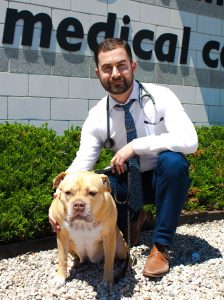-
Adopt
-
Veterinary Care
Services
Client Information
- What to Expect – Angell Boston
- Client Rights and Responsibilities
- Payments / Financial Assistance
- Pharmacy
- Client Policies
- Our Doctors
- Grief Support / Counseling
- Directions and Parking
- Helpful “How-to” Pet Care
Online Payments
Referrals
- Referral Forms/Contact
- Direct Connect
- Referring Veterinarian Portal
- Clinical Articles
- Partners in Care Newsletter
CE, Internships & Alumni Info
CE Seminar Schedule
Emergency: Boston
Emergency: Waltham
Poison Control Hotline
-
Programs & Resources
- Careers
-
Donate Now
 Rob Daniel, DVM, DACVIM (Neurology)
Rob Daniel, DVM, DACVIM (Neurology) ![]()
neurology@angell.org
angell.org/neurology
617-541-5140
A first time seizure in the geriatric pet usually prompts an emergent visit, whether to the general practice and/or an emergent/tertiary care facility. By the time the pet has presented to the hospital, the pet may be fully recovered, experiencing post-ictal signs or actively seizuring.
Epileptic activity in a pet that hasn’t experienced seizures in either recent or distant history offers a myriad of possible causes, after initial questioning has determined that the episode experienced was likely seizure and not one of the ‘great pretenders,’ such as syncopal, vasovagal event, cataplectic or narcoleptic activity. Although late-onset epilepsy is a possibility, consideration should be given to a particular cause for the seizure. Differential diagnoses are degenerative (e.g. cerebral cortical atrophy), metabolic (hypothyroidism, hypoglycemia, nutritional), neoplastic (primary vs. secondary), inflammatory (infectious, non-infectious), traumatic, toxic (endogenous, such as those related to hepatopathy, or exogenous) and vascular.
A point-of-care panel to assess PCV, TP, blood glucose, and BUN is advised, along with blood pressure. Intravenous support through the implementation of an IV catheter should be considered and decided upon based on recent history, clinical examination findings at the time of presentation and initial suggested action plan discussed with the family of the pet. A minimum database can be collected at such a time, and either held or submitted, including a CBC, serum biochemistry profile, urinalysis and thyroid panel. A particular geographic region will often add particular tests to this ‘minimum’ database, such as infectious disease testing.
Both general physical examination and neurologic examination are key in deciding on an action plan. Cardiovascular auscultation and abdominal palpation should be included in the first-time seizure patient. This can help support seizure over a possible syncopal event or a vasovagal episode such as that caused by intra-abdominal hemorrhage secondary to a splenic or hepatic mass. Considering the older age in this signalment and neoplastic differential diagnoses, paying particular attention to the lymph nodes and rectal examination as part of complete examination is advised.
A seizure implies a forebrain neuroanatomic diagnosis and once a detailed history has increased confidence in such a clinical sign, such a neuroanatomic diagnosis can be deduced through reflection alone. Aspects of the neurologic examination that include the forebrain in testing, namely mentation assessment, particular cranial nerve testing such as menace response testing, nasal septum stimulation testing and postural reaction testing, can further support this neuroanatomic diagnosis. Paying particular attention to asymmetry during postural reaction testing and cranial nerve testing can be helpful in increasing suspicion for a particular structural cause, such as a vascular event or neoplastic process. Importantly, the absence of inter-ictal neurologic deficits does not exclude the differential diagnoses that are structural in nature.
Once it has been established that, a seizure has indeed occurred, arriving at a forebrain neuroanatomic diagnosis, the pet has been examined and initial patient support has been instituted, ranging from monitoring in hospital with or without IV access to multipharmacy in trying to control seizure activity, a decision must be made as to whether or not to start maintenance antiepileptic medications. Making such a decision can be relatively straightforward or complicated by comorbidities, the family’s wishes and/or practitioner confidence in deciding on either an appropriate time to start maintenance therapy or an appropriate first line anticonvulsant.
Making the decision of when to start maintenance therapy can often be helped along by signalment of the pet, severity of seizure, seizure frequency (if such a history exists and this is not truly a first time seizure), expected compliance of the family, the family’s wishes regarding treatment and particular anticonvulsant drug choice. In general, instituting maintenance therapy after a second seizure can often be helpful in assessing efficacy of the medication, decision making on behalf of the family to pursue further testing towards establishing a cause for the seizure, and owner compliance. Starting maintenance therapy after a solitary seizure is not wrong, although questions of efficacy may arise as well as doubts on behalf of the family as to whether particular side effects of a given medication are in fact a necessary step in helping to control seizure activity.
Given the widespread use, supply, lower likelihood of side effects, and higher safety index of drugs such as levetiracetam and zonisamide; they are routinely being used as a first-line maintenance therapy. These drugs can often be implemented by the general practitioner, serve as a starting point for further seizure management to build upon, and provide beneficial therapy to increase seizure threshold until the pet is seen by a veterinary neurologist. Starting doses, as well as recommended lab monitoring, can be referenced easily from any one of a number of handbooks in a hospital’s particular library.
Depending on a primary care veterinarian’s proximity to a veterinary specialty center and specifically, a veterinary neurologist, advising an initial neurologic consultation with a board-certified specialist after a first seizure can be helpful. A neurologic consultation can often give the family further directions on both maintenance/rescue therapy and support for managing expectations and is an important step in deciding on definitive testing, including advanced imaging of the brain.